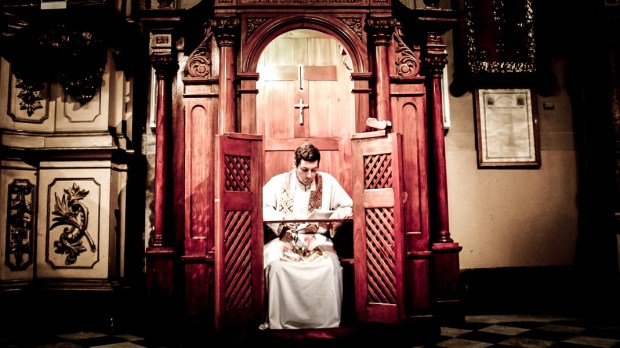Going to confession for the first time in 5, 10, 20, 30 (or more) years can be daunting. We know we should do it, but there is part of us that is still reluctant or even afraid of going back to the sacraments.
Besides feelings of shame, we may simply have forgotten how to go to confession.
For those who are hesitant to receive the mercy of God, here is a practical guide to the various steps of going to confession.
Step 1: Examine your conscience
This is the most necessary part of confession. Before you can confess your sins you need to know them. Typically a person goes to confession and tells the priest the sins they can remember since their last confession. If their last confession was 20 years ago, it might be rather difficult. The key is to tell the priest all mortal sins that you remember (to the best of your ability).
We typically remember those “big” sins, but if you need some help, here is a handy examination of conscience provided by the USCCB. When telling them to the priest, say the sin itself and the number of times you committed it (or at least a general estimation, like, “I didn’t go to Mass for 20 years”).
When thinking of these sins remember that the priest has heard everything before. You are not going to surprise or shock him.
Also, think about confession as going to a doctor. If you don’t tell the doctor your arm hurts, he won’t be able to diagnose it and offer a cure. Similarly, if you don’t tell the priest a sin, he won’t be able to offer absolution for it and help heal that spiritual wound.
Step 2: Look up the local confession times or schedule a time with the priest
Sometimes if it has been a while, it is best to schedule a separate time with the local priest. However, if you don’t know the priest it might be daunting to think about it. Instead, find the nearest parish and inquire about their confession times.
It is also important to go early and try to be near the front of the line.

Read more:
I know we encounter Christ in confession, but I wasn’t expecting THIS!
Step 3: Go into the confessional or Reconciliation room and start your confession
If you haven’t been to confession in many years, you might not know that many parishes no longer use the old-style confessional booths, or may offer them as an option along with one or more Reconciliation rooms. In a room, you still have the option of confessing anonymously behind a movable screen, but you will usually sit in a chair rather than kneel. You may also choose to confess face-to-face. Penitents line up outside the closed door to a Reconciliation room just as they do outside a confessional booth, entering when the person ahead of them leaves.
Wherever confession takes place, the priest typically will start first, saying, “In the name of the Father, and of the Son, and of the Holy Spirit. Amen.” Then it will be your turn to talk. Since it is your first time in a while, it is best to let the priest know that, and say something like, “Father, this is my first confession in x amount of years. These are my sins.”
Then you go ahead and start telling the priest your sins. Do your best to remember them. If you need to, write them on a piece of paper ahead of time.
Step 4: Listen to the priest’s consoling words and say your act of contrition
The priest will respond with words meant to encourage you on your journey of faith. He will then give you a specific “penance,” which could be a number of prayers (like saying 5 Our Fathers), or something related to your sins. After that he will invite you to make an act of contrition, a prayer expressing your sorrow for your sins. If you are worried about that, most confessionals have the act of contrition printed and visible to see. If they don’t, then let the priest know and he will guide you through it.
Alternatively you can print your own copy of the following prayer.
My God, I am sorry for my sins with all my heart. In choosing to do wrong and failing to do good, I have sinned against you whom I should love above all things. I firmly intend, with your help, to do penance, to sin no more, and to avoid whatever leads me to sin. Our Savior Jesus Christ suffered and died for us. In his name, my God, have mercy.
Step 5: Bask in the mercy of God and say your penance
Take a while in the church to thank God for what just happened. God just wiped your sins away! They’re gone. Praise him and allow God’s peace to flood your soul. Then do whatever penance the priest gave you.
Re-commit your life to Jesus Christ, and as you leave the church, start a new chapter in your life. God is always there whenever we fall. Trust in his mercy and allow his grace to permeate every aspect of your life. Plan to head to confession again soon.

Read more:
Come out of your tomb, and get to Confession

